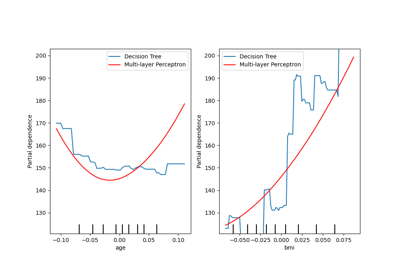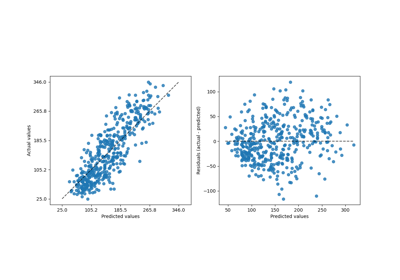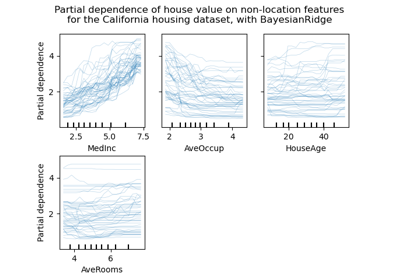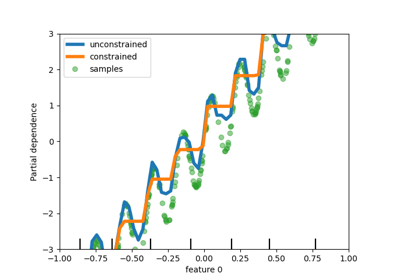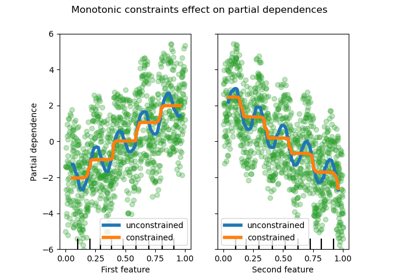sklearn.inspection.PartialDependenceDisplay¶
- class sklearn.inspection.PartialDependenceDisplay(pd_results, *, features, feature_names, target_idx, deciles, kind='average', subsample=1000, random_state=None, is_categorical=None)[source]¶
Partial Dependence Plot (PDP).
This can also display individual partial dependencies which are often referred to as: Individual Condition Expectation (ICE).
It is recommended to use
from_estimatorto create aPartialDependenceDisplay. All parameters are stored as attributes.Read more in Advanced Plotting With Partial Dependence and the User Guide.
New in version 0.22.
- Parameters:
- pd_resultslist of Bunch
Results of
partial_dependenceforfeatures.- featureslist of (int,) or list of (int, int)
Indices of features for a given plot. A tuple of one integer will plot a partial dependence curve of one feature. A tuple of two integers will plot a two-way partial dependence curve as a contour plot.
- feature_nameslist of str
Feature names corresponding to the indices in
features.- target_idxint
In a multiclass setting, specifies the class for which the PDPs should be computed. Note that for binary classification, the positive class (index 1) is always used.
In a multioutput setting, specifies the task for which the PDPs should be computed.
Ignored in binary classification or classical regression settings.
- decilesdict
Deciles for feature indices in
features.- kind{‘average’, ‘individual’, ‘both’} or list of such str, default=’average’
Whether to plot the partial dependence averaged across all the samples in the dataset or one line per sample or both.
kind='average'results in the traditional PD plot;kind='individual'results in the ICE plot;kind='both'results in plotting both the ICE and PD on the same plot.
A list of such strings can be provided to specify
kindon a per-plot basis. The length of the list should be the same as the number of interaction requested infeatures.Note
ICE (‘individual’ or ‘both’) is not a valid option for 2-ways interactions plot. As a result, an error will be raised. 2-ways interaction plots should always be configured to use the ‘average’ kind instead.
Note
The fast
method='recursion'option is only available forkind='average'andsample_weights=None. Computing individual dependencies and doing weighted averages requires using the slowermethod='brute'.New in version 0.24: Add
kindparameter with'average','individual', and'both'options.New in version 1.1: Add the possibility to pass a list of string specifying
kindfor each plot.- subsamplefloat, int or None, default=1000
Sampling for ICE curves when
kindis ‘individual’ or ‘both’. If float, should be between 0.0 and 1.0 and represent the proportion of the dataset to be used to plot ICE curves. If int, represents the maximum absolute number of samples to use.Note that the full dataset is still used to calculate partial dependence when
kind='both'.New in version 0.24.
- random_stateint, RandomState instance or None, default=None
Controls the randomness of the selected samples when subsamples is not
None. See Glossary for details.New in version 0.24.
- is_categoricallist of (bool,) or list of (bool, bool), default=None
Whether each target feature in
featuresis categorical or not. The list should be same size asfeatures. IfNone, all features are assumed to be continuous.New in version 1.2.
- Attributes:
- bounding_ax_matplotlib Axes or None
If
axis an axes or None, thebounding_ax_is the axes where the grid of partial dependence plots are drawn. Ifaxis a list of axes or a numpy array of axes,bounding_ax_is None.- axes_ndarray of matplotlib Axes
If
axis an axes or None,axes_[i, j]is the axes on the i-th row and j-th column. Ifaxis a list of axes,axes_[i]is the i-th item inax. Elements that are None correspond to a nonexisting axes in that position.- lines_ndarray of matplotlib Artists
If
axis an axes or None,lines_[i, j]is the partial dependence curve on the i-th row and j-th column. Ifaxis a list of axes,lines_[i]is the partial dependence curve corresponding to the i-th item inax. Elements that are None correspond to a nonexisting axes or an axes that does not include a line plot.- deciles_vlines_ndarray of matplotlib LineCollection
If
axis an axes or None,vlines_[i, j]is the line collection representing the x axis deciles of the i-th row and j-th column. Ifaxis a list of axes,vlines_[i]corresponds to the i-th item inax. Elements that are None correspond to a nonexisting axes or an axes that does not include a PDP plot.New in version 0.23.
- deciles_hlines_ndarray of matplotlib LineCollection
If
axis an axes or None,vlines_[i, j]is the line collection representing the y axis deciles of the i-th row and j-th column. Ifaxis a list of axes,vlines_[i]corresponds to the i-th item inax. Elements that are None correspond to a nonexisting axes or an axes that does not include a 2-way plot.New in version 0.23.
- contours_ndarray of matplotlib Artists
If
axis an axes or None,contours_[i, j]is the partial dependence plot on the i-th row and j-th column. Ifaxis a list of axes,contours_[i]is the partial dependence plot corresponding to the i-th item inax. Elements that are None correspond to a nonexisting axes or an axes that does not include a contour plot.- bars_ndarray of matplotlib Artists
If
axis an axes or None,bars_[i, j]is the partial dependence bar plot on the i-th row and j-th column (for a categorical feature). Ifaxis a list of axes,bars_[i]is the partial dependence bar plot corresponding to the i-th item inax. Elements that are None correspond to a nonexisting axes or an axes that does not include a bar plot.New in version 1.2.
- heatmaps_ndarray of matplotlib Artists
If
axis an axes or None,heatmaps_[i, j]is the partial dependence heatmap on the i-th row and j-th column (for a pair of categorical features) . Ifaxis a list of axes,heatmaps_[i]is the partial dependence heatmap corresponding to the i-th item inax. Elements that are None correspond to a nonexisting axes or an axes that does not include a heatmap.New in version 1.2.
- figure_matplotlib Figure
Figure containing partial dependence plots.
See also
partial_dependenceCompute Partial Dependence values.
PartialDependenceDisplay.from_estimatorPlot Partial Dependence.
Examples
>>> import numpy as np >>> import matplotlib.pyplot as plt >>> from sklearn.datasets import make_friedman1 >>> from sklearn.ensemble import GradientBoostingRegressor >>> from sklearn.inspection import PartialDependenceDisplay >>> from sklearn.inspection import partial_dependence >>> X, y = make_friedman1() >>> clf = GradientBoostingRegressor(n_estimators=10).fit(X, y) >>> features, feature_names = [(0,)], [f"Features #{i}" for i in range(X.shape[1])] >>> deciles = {0: np.linspace(0, 1, num=5)} >>> pd_results = partial_dependence( ... clf, X, features=0, kind="average", grid_resolution=5) >>> display = PartialDependenceDisplay( ... [pd_results], features=features, feature_names=feature_names, ... target_idx=0, deciles=deciles ... ) >>> display.plot(pdp_lim={1: (-1.38, 0.66)}) <...> >>> plt.show()
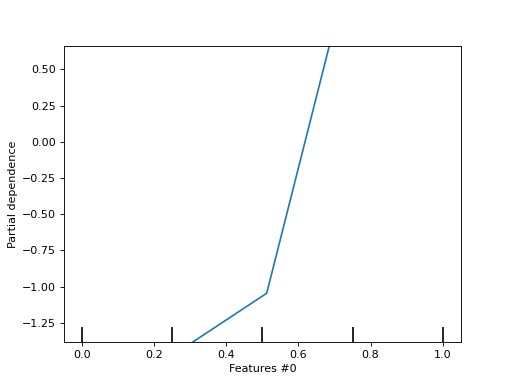
Methods
from_estimator(estimator, X, features, *[, ...])Partial dependence (PD) and individual conditional expectation (ICE) plots.
plot(*[, ax, n_cols, line_kw, ice_lines_kw, ...])Plot partial dependence plots.
- classmethod from_estimator(estimator, X, features, *, sample_weight=None, categorical_features=None, feature_names=None, target=None, response_method='auto', n_cols=3, grid_resolution=100, percentiles=(0.05, 0.95), method='auto', n_jobs=None, verbose=0, line_kw=None, ice_lines_kw=None, pd_line_kw=None, contour_kw=None, ax=None, kind='average', centered=False, subsample=1000, random_state=None)[source]¶
Partial dependence (PD) and individual conditional expectation (ICE) plots.
Partial dependence plots, individual conditional expectation plots or an overlay of both of them can be plotted by setting the
kindparameter. Thelen(features)plots are arranged in a grid withn_colscolumns. Two-way partial dependence plots are plotted as contour plots. The deciles of the feature values will be shown with tick marks on the x-axes for one-way plots, and on both axes for two-way plots.Read more in the User Guide.
Note
PartialDependenceDisplay.from_estimatordoes not support using the same axes with multiple calls. To plot the partial dependence for multiple estimators, please pass the axes created by the first call to the second call:>>> from sklearn.inspection import PartialDependenceDisplay >>> from sklearn.datasets import make_friedman1 >>> from sklearn.linear_model import LinearRegression >>> from sklearn.ensemble import RandomForestRegressor >>> X, y = make_friedman1() >>> est1 = LinearRegression().fit(X, y) >>> est2 = RandomForestRegressor().fit(X, y) >>> disp1 = PartialDependenceDisplay.from_estimator(est1, X, ... [1, 2]) >>> disp2 = PartialDependenceDisplay.from_estimator(est2, X, [1, 2], ... ax=disp1.axes_)
Warning
For
GradientBoostingClassifierandGradientBoostingRegressor, the'recursion'method (used by default) will not account for theinitpredictor of the boosting process. In practice, this will produce the same values as'brute'up to a constant offset in the target response, provided thatinitis a constant estimator (which is the default). However, ifinitis not a constant estimator, the partial dependence values are incorrect for'recursion'because the offset will be sample-dependent. It is preferable to use the'brute'method. Note that this only applies toGradientBoostingClassifierandGradientBoostingRegressor, not toHistGradientBoostingClassifierandHistGradientBoostingRegressor.New in version 1.0.
- Parameters:
- estimatorBaseEstimator
A fitted estimator object implementing predict, predict_proba, or decision_function. Multioutput-multiclass classifiers are not supported.
- X{array-like, dataframe} of shape (n_samples, n_features)
Xis used to generate a grid of values for the targetfeatures(where the partial dependence will be evaluated), and also to generate values for the complement features when themethodis'brute'.- featureslist of {int, str, pair of int, pair of str}
The target features for which to create the PDPs. If
features[i]is an integer or a string, a one-way PDP is created; iffeatures[i]is a tuple, a two-way PDP is created (only supported withkind='average'). Each tuple must be of size 2. If any entry is a string, then it must be infeature_names.- sample_weightarray-like of shape (n_samples,), default=None
Sample weights are used to calculate weighted means when averaging the model output. If
None, then samples are equally weighted. Ifsample_weightis notNone, thenmethodwill be set to'brute'. Note thatsample_weightis ignored forkind='individual'.New in version 1.3.
- categorical_featuresarray-like of shape (n_features,) or shape (n_categorical_features,), dtype={bool, int, str}, default=None
Indicates the categorical features.
None: no feature will be considered categorical;boolean array-like: boolean mask of shape
(n_features,)indicating which features are categorical. Thus, this array has the same shape hasX.shape[1];integer or string array-like: integer indices or strings indicating categorical features.
New in version 1.2.
- feature_namesarray-like of shape (n_features,), dtype=str, default=None
Name of each feature;
feature_names[i]holds the name of the feature with indexi. By default, the name of the feature corresponds to their numerical index for NumPy array and their column name for pandas dataframe.- targetint, default=None
In a multiclass setting, specifies the class for which the PDPs should be computed. Note that for binary classification, the positive class (index 1) is always used.
In a multioutput setting, specifies the task for which the PDPs should be computed.
Ignored in binary classification or classical regression settings.
- response_method{‘auto’, ‘predict_proba’, ‘decision_function’}, default=’auto’
Specifies whether to use predict_proba or decision_function as the target response. For regressors this parameter is ignored and the response is always the output of predict. By default, predict_proba is tried first and we revert to decision_function if it doesn’t exist. If
methodis'recursion', the response is always the output of decision_function.- n_colsint, default=3
The maximum number of columns in the grid plot. Only active when
axis a single axis orNone.- grid_resolutionint, default=100
The number of equally spaced points on the axes of the plots, for each target feature.
- percentilestuple of float, default=(0.05, 0.95)
The lower and upper percentile used to create the extreme values for the PDP axes. Must be in [0, 1].
- methodstr, default=’auto’
The method used to calculate the averaged predictions:
'recursion'is only supported for some tree-based estimators (namelyGradientBoostingClassifier,GradientBoostingRegressor,HistGradientBoostingClassifier,HistGradientBoostingRegressor,DecisionTreeRegressor,RandomForestRegressorbut is more efficient in terms of speed. With this method, the target response of a classifier is always the decision function, not the predicted probabilities. Since the'recursion'method implicitly computes the average of the ICEs by design, it is not compatible with ICE and thuskindmust be'average'.'brute'is supported for any estimator, but is more computationally intensive.'auto': the'recursion'is used for estimators that support it, and'brute'is used otherwise. Ifsample_weightis notNone, then'brute'is used regardless of the estimator.
Please see this note for differences between the
'brute'and'recursion'method.- n_jobsint, default=None
The number of CPUs to use to compute the partial dependences. Computation is parallelized over features specified by the
featuresparameter.Nonemeans 1 unless in ajoblib.parallel_backendcontext.-1means using all processors. See Glossary for more details.- verboseint, default=0
Verbose output during PD computations.
- line_kwdict, default=None
Dict with keywords passed to the
matplotlib.pyplot.plotcall. For one-way partial dependence plots. It can be used to define common properties for bothice_lines_kwandpdp_line_kw.- ice_lines_kwdict, default=None
Dictionary with keywords passed to the
matplotlib.pyplot.plotcall. For ICE lines in the one-way partial dependence plots. The key value pairs defined inice_lines_kwtakes priority overline_kw.- pd_line_kwdict, default=None
Dictionary with keywords passed to the
matplotlib.pyplot.plotcall. For partial dependence in one-way partial dependence plots. The key value pairs defined inpd_line_kwtakes priority overline_kw.- contour_kwdict, default=None
Dict with keywords passed to the
matplotlib.pyplot.contourfcall. For two-way partial dependence plots.- axMatplotlib axes or array-like of Matplotlib axes, default=None
If a single axis is passed in, it is treated as a bounding axes and a grid of partial dependence plots will be drawn within these bounds. The
n_colsparameter controls the number of columns in the grid.If an array-like of axes are passed in, the partial dependence plots will be drawn directly into these axes.
If
None, a figure and a bounding axes is created and treated as the single axes case.
- kind{‘average’, ‘individual’, ‘both’}, default=’average’
Whether to plot the partial dependence averaged across all the samples in the dataset or one line per sample or both.
kind='average'results in the traditional PD plot;kind='individual'results in the ICE plot.
Note that the fast
method='recursion'option is only available forkind='average'andsample_weights=None. Computing individual dependencies and doing weighted averages requires using the slowermethod='brute'.- centeredbool, default=False
If
True, the ICE and PD lines will start at the origin of the y-axis. By default, no centering is done.New in version 1.1.
- subsamplefloat, int or None, default=1000
Sampling for ICE curves when
kindis ‘individual’ or ‘both’. Iffloat, should be between 0.0 and 1.0 and represent the proportion of the dataset to be used to plot ICE curves. Ifint, represents the absolute number samples to use.Note that the full dataset is still used to calculate averaged partial dependence when
kind='both'.- random_stateint, RandomState instance or None, default=None
Controls the randomness of the selected samples when subsamples is not
Noneandkindis either'both'or'individual'. See Glossary for details.
- Returns:
- display
PartialDependenceDisplay
- display
See also
partial_dependenceCompute Partial Dependence values.
Examples
>>> import matplotlib.pyplot as plt >>> from sklearn.datasets import make_friedman1 >>> from sklearn.ensemble import GradientBoostingRegressor >>> from sklearn.inspection import PartialDependenceDisplay >>> X, y = make_friedman1() >>> clf = GradientBoostingRegressor(n_estimators=10).fit(X, y) >>> PartialDependenceDisplay.from_estimator(clf, X, [0, (0, 1)]) <...> >>> plt.show()
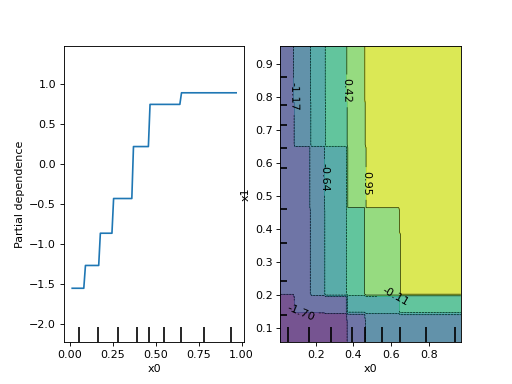
- plot(*, ax=None, n_cols=3, line_kw=None, ice_lines_kw=None, pd_line_kw=None, contour_kw=None, bar_kw=None, heatmap_kw=None, pdp_lim=None, centered=False)[source]¶
Plot partial dependence plots.
- Parameters:
- axMatplotlib axes or array-like of Matplotlib axes, default=None
- If a single axis is passed in, it is treated as a bounding axes
and a grid of partial dependence plots will be drawn within these bounds. The
n_colsparameter controls the number of columns in the grid.
- If an array-like of axes are passed in, the partial dependence
plots will be drawn directly into these axes.
- If
None, a figure and a bounding axes is created and treated as the single axes case.
- If
- n_colsint, default=3
The maximum number of columns in the grid plot. Only active when
axis a single axes orNone.- line_kwdict, default=None
Dict with keywords passed to the
matplotlib.pyplot.plotcall. For one-way partial dependence plots.- ice_lines_kwdict, default=None
Dictionary with keywords passed to the
matplotlib.pyplot.plotcall. For ICE lines in the one-way partial dependence plots. The key value pairs defined inice_lines_kwtakes priority overline_kw.New in version 1.0.
- pd_line_kwdict, default=None
Dictionary with keywords passed to the
matplotlib.pyplot.plotcall. For partial dependence in one-way partial dependence plots. The key value pairs defined inpd_line_kwtakes priority overline_kw.New in version 1.0.
- contour_kwdict, default=None
Dict with keywords passed to the
matplotlib.pyplot.contourfcall for two-way partial dependence plots.- bar_kwdict, default=None
Dict with keywords passed to the
matplotlib.pyplot.barcall for one-way categorical partial dependence plots.New in version 1.2.
- heatmap_kwdict, default=None
Dict with keywords passed to the
matplotlib.pyplot.imshowcall for two-way categorical partial dependence plots.New in version 1.2.
- pdp_limdict, default=None
Global min and max average predictions, such that all plots will have the same scale and y limits.
pdp_lim[1]is the global min and max for single partial dependence curves.pdp_lim[2]is the global min and max for two-way partial dependence curves. IfNone(default), the limit will be inferred from the global minimum and maximum of all predictions.New in version 1.1.
- centeredbool, default=False
If
True, the ICE and PD lines will start at the origin of the y-axis. By default, no centering is done.New in version 1.1.
- Returns:
- display
PartialDependenceDisplay Returns a
PartialDependenceDisplayobject that contains the partial dependence plots.
- display
Examples using sklearn.inspection.PartialDependenceDisplay¶
Examples using sklearn.inspection.PartialDependenceDisplay.from_estimator¶
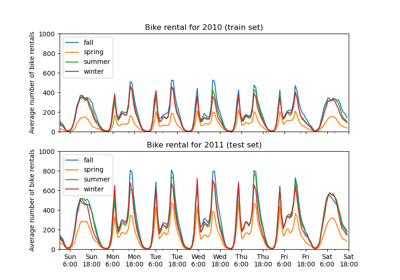
Partial Dependence and Individual Conditional Expectation Plots
